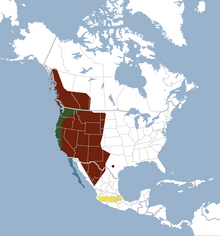Long-legged mouse-eared
| Long-legged mouse-eared | ||||||||||||
|---|---|---|---|---|---|---|---|---|---|---|---|---|

Long-legged mouse-eared mouse ( Myotis volans ) |
||||||||||||
| Systematics | ||||||||||||
|
||||||||||||
| Scientific name | ||||||||||||
| Myotis volans | ||||||||||||
| ( Allen , 1866) |
The long-legged mouse- eared bat ( Myotis volans ) is a species of bat from the smooth-nosed family (Vespertilionidae), which is native to North America.
The species name is derived from the Latin "volans" (= to fly).
description
The total length of the long-legged mouse-eared ear is 83-106 mm, the forearm length 37-41.2 mm and the wingspan on average 267.4 mm. The tragus is 6-8 mm long and tapering. The coat color is variable gray-brown with a reddish or black tint on the back and a lighter belly. The skin and ears are black. The long-legged mouse- eared bats differ from all other North American bats in that they have short, round ears which, when placed forward, do not reach the nostrils, the small feet (about 41% of the tibial length ) and a strongly curved calcar . Other species with a curved calcar ( M. leibii and M. californicus ), which occur in the same area as the long-legged mouse-eared mouse, are much smaller. On the underside of the flight membrane, the hair extends to an imaginary line between the elbow and the knee. Although other mouse-ears can have a hairy flight skin, that of the long-legged mouse-ear is particularly long, dense and pronounced. The small brown bat ( M. lucifugus ), M. velifer and M. yumanensis do not have a curved calcar and no thick hair on the underside of the wing.
Way of life
The long-legged mouse-eared mouse, like most bats, is nocturnal and feeds on insects. The preferred prey animals include moths , flies (Diptera), termites (Isoptera), reticulated winged (Neuroptera), wasps (Hymenoptera), beaked beetles ( Hemiptera), constant winged (Homoptera) and small beetles (Coleoptera). On foraging flights, the long-legged mouse-eared mouse reaches a speed of 15-17 km / h. The echolocation calls emitted in the process range between 89 and 40 kHz and are therefore imperceptible to the human ear.
The long-legged mouse-eared mouse is mainly found in coniferous forests , but also in river landscapes and even in desert-like areas. During the day, the species hides in abandoned buildings, in crevices and under loose tree bark. Caves and mines are used for hibernation . The long-legged mouse-eared mouse is active up to a temperature minimum of 12 ° C and is therefore relatively cold-tolerant.
Mating takes place in August and September, with the female storing the sperm over the winter. After ovulation in spring between March and May, the egg cell is then fertilized. The boys are born between May and August. It is known from ringing data that representatives of this species can live to be over 21 years old.
distribution and habitat
The long-legged mouse-eared mouse is found in eastern Canada , the United States, and Mexico . In the west, their distribution extends to North Dakota , South Dakota , Nebraska , Colorado and Texas . Its population is classified as safe by the IUCN thanks to its wide distribution area.
literature
- RM Warner & NJ Czaplewski (1984): Myotis volans . In: Mammalian Species , No. 224, pp. 1-4
swell
- ↑ Myotis volans in the IUCN Red List of Threatened Species .
